
The National Gallery of Victoria, popularly known as the NGV, is an art museum in Melbourne, Victoria, Australia. Founded in 1861, it is Australia's oldest and most visited art museum.

The Victorian Artists Society, which can trace its establishment to 1856 in Melbourne, promotes artistic education, art classes and gallery hire exhibition in Australia. It was formed in March 1888 when the Victorian Academy of Arts and the Australian Artists' Association amalgamated.

Australian art is a broad spectrum of art created in or about Australia, or by Australians overseas, spanning from prehistoric times to the present day. The art forms include, but are not limited to, Aboriginal, Colonial, Landscape, Atelier, and Contemporary art.
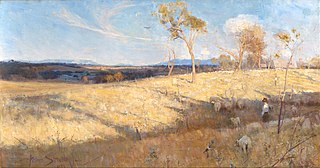
The Heidelberg School was an Australian art movement of the late 19th century. It has been described as Australian impressionism.
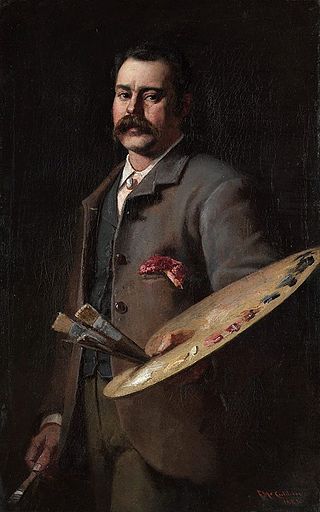
Frederick McCubbin was an Australian artist, art teacher and prominent member of the Heidelberg School art movement, also known as Australian impressionism.
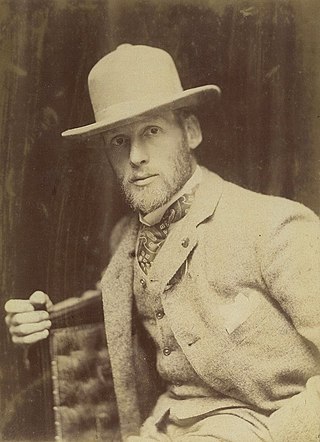
Thomas William Roberts was an English-born Australian artist and a key member of the Heidelberg School art movement, also known as Australian impressionism.

Sir Arthur Ernest Streeton was an Australian landscape painter and a leading member of the Heidelberg School, also known as Australian Impressionism.
The Joseph Brown Collection comprises works of art donated to the National Gallery of Victoria in 2004 by the collector and art dealer Joseph Brown. The collection is displayed in the Ian Potter Centre, part of the NGV. More than 150 works are on display at the centre.

Johann Joseph Eugene von Guérard was an Austrian-born artist, active in Australia from 1852 until 1882. Known for his finely detailed landscapes in the tradition of the Düsseldorf school of painting, he is represented in Australia's major public galleries, and is referred to in the country as Eugene von Guerard.
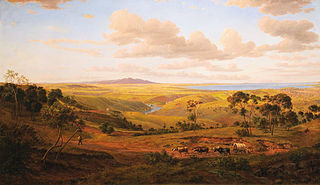
View of Geelong is an 1856 oil painting on canvas by Eugene von Guerard. The painting measures 154.5 x 89 cm and is owned by the Geelong Art Gallery in Victoria, Australia.
Tyrone Wright, better known by his pseudonym Rone, is an Australian street artist based in Melbourne.

Walter Herbert Withers was an English-born Australian landscape artist and a member of the Heidelberg School of Australian impressionists.

The Art Gallery of Ballarat is the oldest regional art gallery in Australia. It was established in 1884 as the Ballarat Fine Art Gallery by a company of interested citizens led by James Oddie. It initially rented out the first floor of the Ballarat Academy of Music; the current building on Lydiard Street North opened in 1890. The gallery was privately owned until financial insecurity led to the building and collection being handed over to the Ballarat City Council in 1977. In 2008, the gallery adopted its current name and became a free-entry venue. Louise Tegart is the gallery's current director.

Market Square Shopping Centre is located in Geelong, Victoria, Australia. The shopping centre was named after the original town square of Geelong on which the shopping centre is constructed. The centre is surrounded by Little Malop, Moorabool, Malop, and Yarra Streets. Market Square is located on the southern side of Malop Street opposite the Westfield Geelong shopping complex, the two of which together make up Geelong's Central Shopping Complex.

Johnstone Park is a landscaped garden in Geelong, Victoria, Australia. It is bounded by Railway Terrace, Gheringhap Street, Little Malop Street, Fenwick Street, and Mercer Street. The park is surrounded by civic buildings including the Geelong City Hall, Geelong Art Gallery, Geelong Library, Geelong Law Courts, and the Geelong Railway Station. A war memorial and bandstand feature in the centre of the park.
The National Gallery of Victoria Art School, associated with the National Gallery of Victoria, was a private fine arts college founded in 1867 and was Australia's leading art school of 50 years.

Violet Helen Evangeline Teague was an Australian artist, noted for her painting, printmaking and her critical writings on art.

The Gippsland Art Gallery, formerly Sale Regional Art Centre, is a Victorian Regional Public Gallery based in Sale, 220 km (140 mi) east of Melbourne. The gallery is operated by the Shire of Wellington, and has a focus on the natural environment and artists based in Gippsland.
Stephen Wickham is an Australian photographer, painter and printmaker.
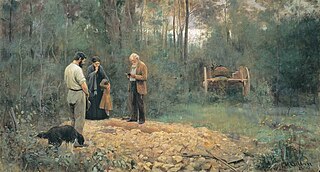
A bush burial is an 1890 painting by the Australian artist Frederick McCubbin. The painting depicts a burial attended by a small group - an older man reading from a book, a younger man with a dog, and a woman and child. The relationships between the figures is unclear and its ambiguity and sentimental nature has seen the work described as a frontier example of the Victorian-era problem pictures. From the time the painting was shown at the Victorian Artists Society Winter Exhibition in 1890, there has been differing opinions on the story told by the work with "the critic for Table Talk magazine writ[ing] that the woman is newly widowed. In The Argus, she is the grief-stricken mother of a dead child." The Age referred to the "deceased, doubtless the wife of the grey-haired old man reading the service." The burial itself also refers to the memento mori tradition.
Like Dutch vanitas pictures of the 17th century – with their skulls and snuffed candles, and fruit and flowers past their use-by date – McCubbin is reminding the viewer of the inevitability of death. You can almost hear the words being read over the grave: “Earth to earth, ashes to ashes, dust to dust.



















